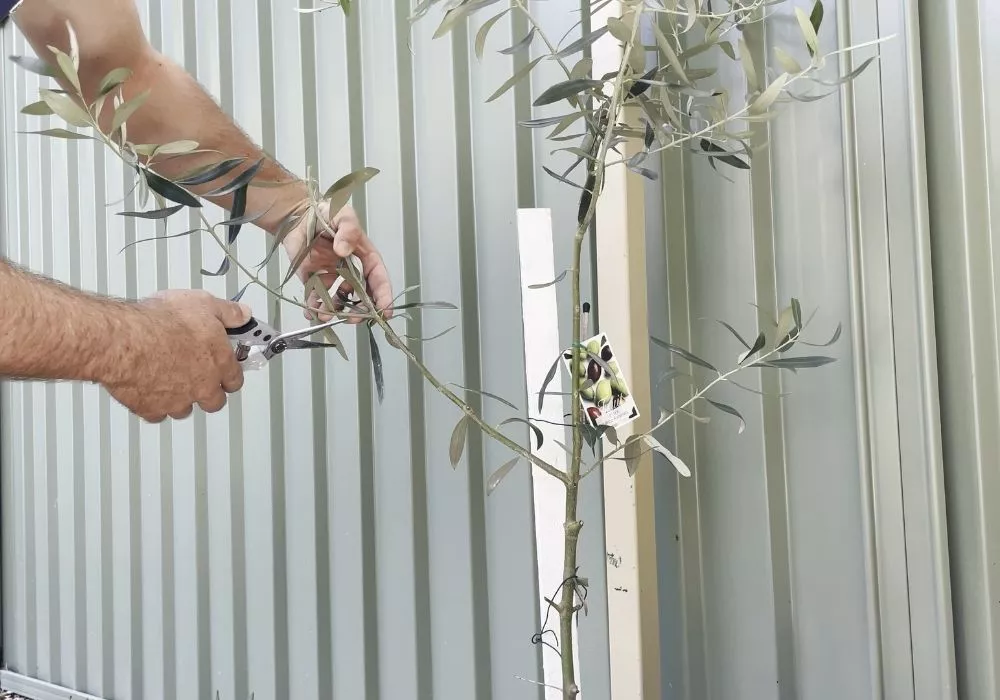Olive trees can be propagated by three different propagation methods. The three olive tree propagation techniques are:
Olive Tree Cutting
You can propagate an olive tree by taking a cutting from an existing tree. Click here to see how I do it.
Air Layering Olive Tree Branch
Using the air layering method is (in my opinion) the easiest way to propagate an olive tree. Read my instruction on how to do this here.
With An Olive Tree Seed (Pit)
The process of germinating an olive tree from seed can take 1-2 months and is the less favoured method of propagating olive trees as there is no guarantee that the seed will grow an olive tree that is similar to when the seed came from. Growers prefer to propagate olive trees with cuttings because it will be a close clone of the tree that it was taken from.
But if you would like to try it I will link to a blog post on how to do it once published.
How To Grow Olive Trees From Cuttings
Olive trees can be propagated from cuttings of an existing tree. Growers like using this method when propagating olive trees because they are guaranteed a clone of the tree that they are taking the cutting from. Whereas growing an olive tree from seed can have mixed results.
This method of propagating an olive tree is best done during the summer growth period when there is new growth on the tree.
The steps to propagate an olive tree from cutting are:
1. Get Your Olive Tree Cutting
Take a cutting from an existing tree. Ideally, the cutting size will be 4-8 inches long and be as think as a pencil (6 millimetres/quarter of an inch).
Before taking your cutting make sure your secateurs are sharp and clean to avoid the risk of spreading disease.
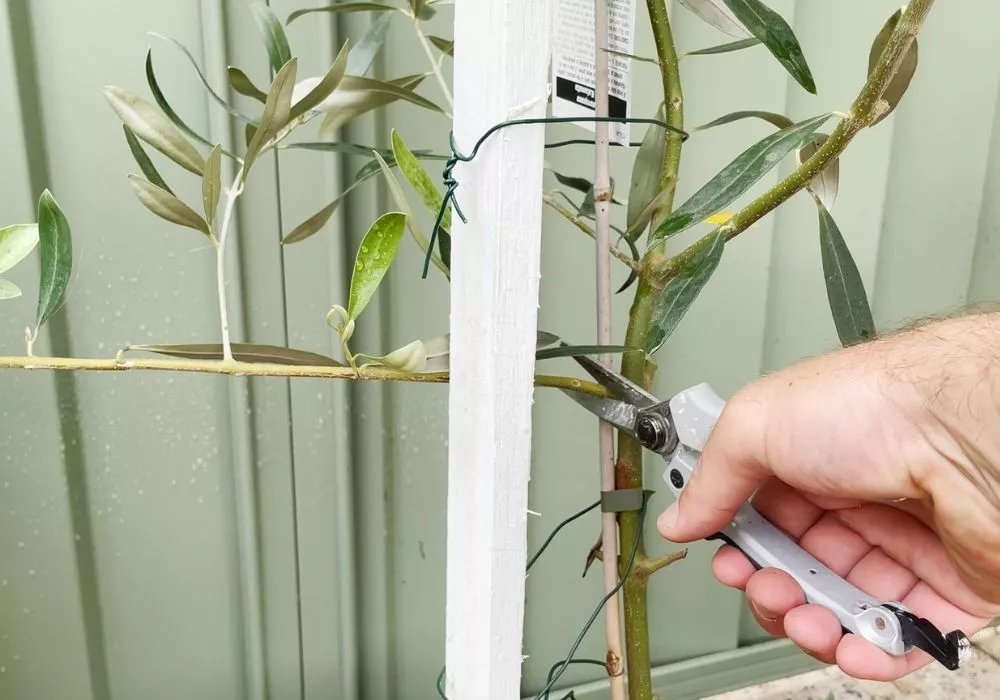
2. Prepare Olive Tree Cutting
Remove all the leaves from the lower end of the branch, leaving 3-6 leaves at the top of the cutting.
With your secateurs or a utility knife, you can scratch the bottom of the olive tree cutting to remove some of the outer bark of the cutting. Then dip the end of the cutting in rooting hormone powder.
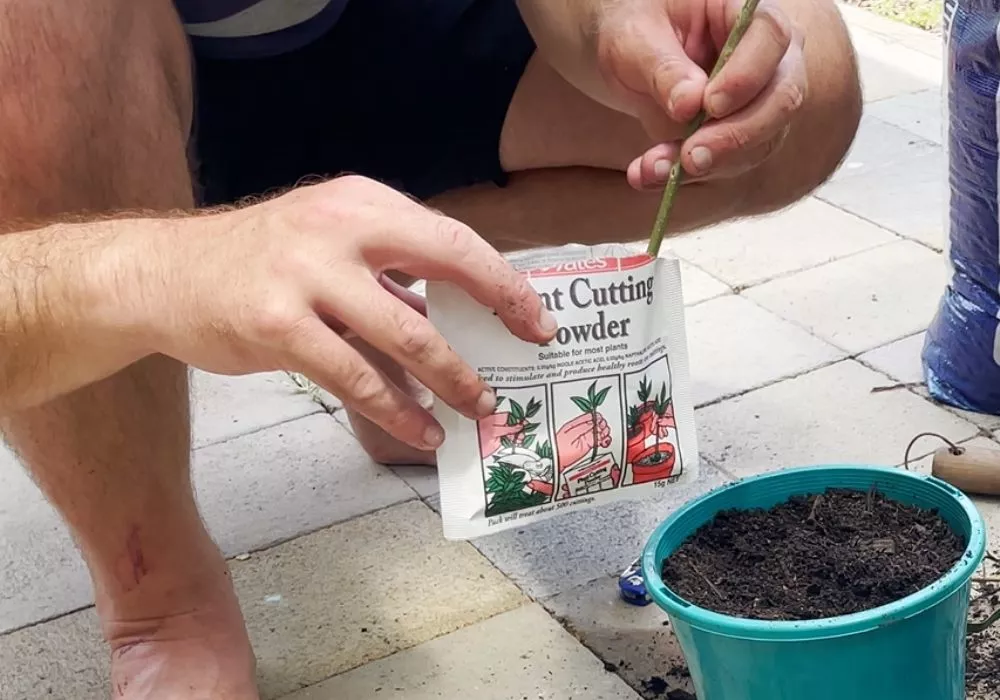
3. Pot Olive Tree Cutting
Fill a pot with seed and cutting potting mix (I use this one), this type of mix retains more moisture to prevent the cutting from drying out. Otherwise, you can mix your own using this guide from Savvy Gardening.
The ideal size of pot would be a 100mm-200mm grow pot, with drainage holes at the bottom of the pot.
Insert the end of the cutting 1 to 1.5 inches into the potting mix.
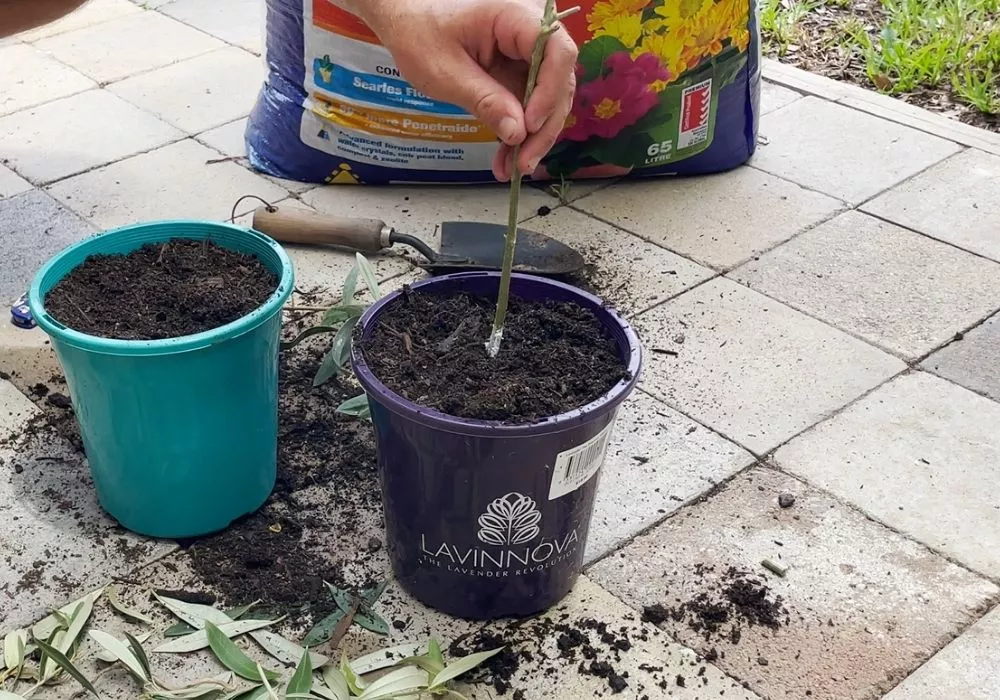
4. Watering The Olive Tree Cutting
Water the newly potted cutting until the whole pot is wet and water is draining out the bottom.
Then mist the leaves of the olive tree each day or two (depending on your climate) to prevent it from drying out, and only water the soil sparingly when the soil is dry to reduce the change of the cutting rotting.
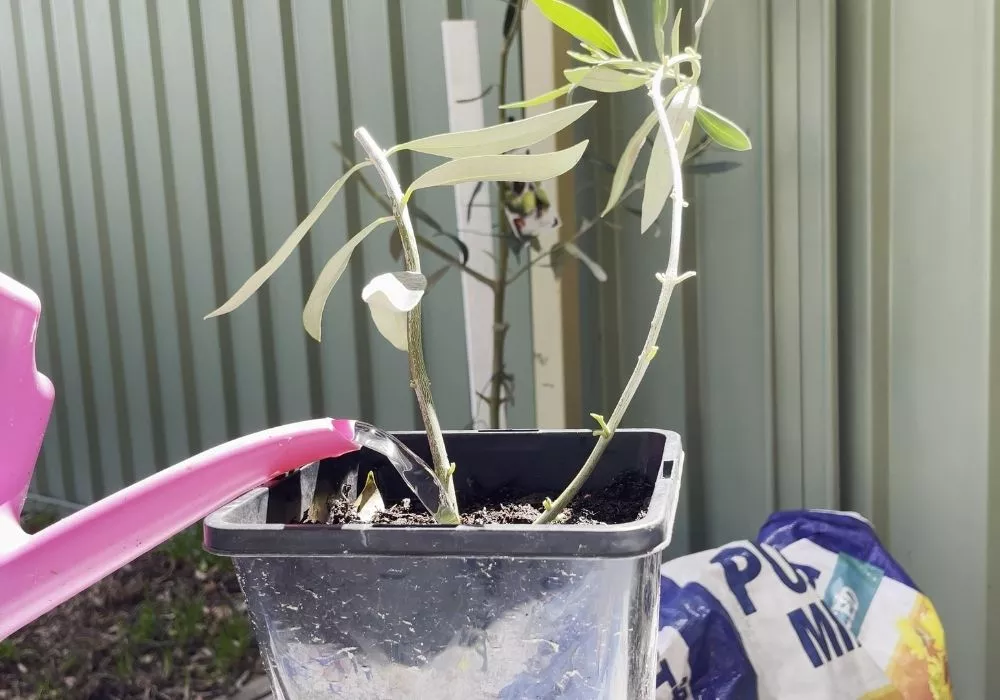
5. Ongoing Care
Place the cuttings somewhere out of direct light but that is also warm. Mist the leaves with water 2-3 times a day, and wet the soil when it becomes dry.
Once roots being to grow from the cutting the watering schedule can be reduced to just once a week and misting the cuttings won’t be required anymore.
To help prevent the cutting from drying out you can either place the cutting in a protected spot in a greenhouse or somewhere in your house where it will receive indirect light. You can also place a plastic bag over the top of the tree to help keep the moisture in, make sure some slits are cut in the plastic bag though to prevent mould from growing and wrecking your cutting.
Video On How To Propagate Olive Tree With Cutting
How To Propagate Olive Tree Using Air Layering Method
Air layering is when low hanging branches come into contact with the ground, and then begin to form their own root system. This is my preferred method of propagating an olive tree as it has an almost 100% success rate, and it is far easier than propagating from olive pips or cuttings.
Nurseries and horticulturists prefer this method of growing new olive trees as the offspring will be genetically close to the parent tree.
Equipment Requird For Aerial Layering
- Plastic coated wire,
- Secuteurs/utility knife,
- Match sticks,
- Clear plastic wrap and alumimum foil,
- Cocopeat (sphagnum moss)
- Honey, and
- Hormon rooting powder.
The method to propagate olive trees using the air layering method is:
1. Select An Appropiate Stem
Ideally, the stem you select will be approximately half an inch (1-1.5cm) thick and be new growth that hasn’t had a chance to harden.
2. Cut 1/3 The Way Into The Branch
Using the secateurs or knife cut almost halfway through the branch in an upward direction (almost 45 degrees).
3. Treat The Cut
To reduce the risk of the cut getting infected, dab some honey around it to seal the wound. Then dust some rooting powder on the honey to help encourage root growth.
If you have some match stick on hand, you can insert the trimmed off the end of it into the cut in the branch to hold open the cut. This will hold the wound open which may help the roots form.
4. Wrap Rooting Medium Around Cut
Add some presoaked cocopeat (or sphagnum moss) to the clear plastic wrap, and then wrap it around the cut on the olive tree branch. This acts as an aerial pot that will have roots growing in it.
To help protect the roots that grow from heat or direct sunlight, wrap the aluminium foil around the clear plastic wrap, and then tie each end with the plastic-coated tie wire to secure it in place.
5. Pot Branch With Roots Growing On It
You can’t check on the root growth progress without removing the aerial pot, so I would recommend leaving the aerial pot tied in place for two months which is long enough that some roots should have started growing.
When you do check it and if there are roots growing you can cut the branch off beneath the roots and plant it into a pot.
How To Grow An Olive Tree From A Pip (Seed)
You can only attempt to germinate olive seeds that come straight from a tree, and that has not been processed or soaked in oil as you might get from a supermarket. The steps to growing an olive tree from a seed (pip) are:
- Remove the flesh from around the seed, and leave the seed dry out for 1-2 days. Don’t leave the seed in direct sunlight all day, just some indirect sunlight so the pit drys out but the seed inside doesn’t get damaged.
- Once the pit is dry, using a pair of scissors or a knofe but open the pit. Being careful not to damage the seed inside.
- Once you have the seed from inside the pit please in a small pot (that has drainage holes) with some potting mix that is ideal for growing seeds. Pleant the seed 1-2 inches deep.
- Place the pot in a sunny area and water the olive seed daily so it doesn’t dry out.
If you follow the above steps you can expect that the olive seed will germinate in 1-2 months.
Olive Tree Propagation FAQs
How Do You Encourage Roots To Grow From Cuttings?
To encourage root growth from olive tree cuttings you can scratch the bottom of the olive tree cutting with a sharp blade from either a utility knife or a pair of secateurs, and then apply rooting hormone to the exposed part of the branch.
When To Take Olive Tree Cuttings?
Ideally, you would take olive tree cuttings in the summer just after new growth has come through. Don’t wait until just before winter to start your cuttings though as olive tree cuttings need heat to encourage root growth.
Can You Root Olive Tree Cuttings In Water?
Olive tree cuttings won’t root in water. However, you can start the olive tree cutting propagation process by placing new olive tree cuttings in a cup of water for the first 2-3 days before transferring to a pot with potting mix.
How Long Does It Take The Newly Propagated Olive Tree To Produce Olives?
Olive trees can take several years before they bear fruit, this could be between 3-5 years.
How Long Does It Take For Olive Tree Cuttings To Root?
It can take up to 4 weeks for roots to being to develop in olive tree cutting, but this can vary depending on the type of tree and the environment (temperature, humidity, light) conditions.
Can You Grow An Olive Tree From A Branch?
Yes, you can grow an olive tree from a branch. This method of growing an olive tree is called propagation when you use an existing plant to grow another plant.

